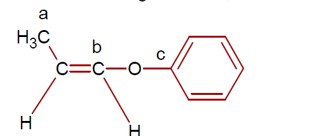Class 11th
Get insights from 8k questions on Class 11th, answered by students, alumni, and experts. You may also ask and answer any question you like about Class 11th
Follow Ask QuestionQuestions
Discussions
Active Users
Followers
New answer posted
2 months agoContributor-Level 9
Oxidation state of N
| NO | +2 |
|-|-|
| NO? | +4 |
| N? O | +1 |
| NO? | +5 |
So, order of oxidation state is
NO? > NO? > NO > N? O
New answer posted
2 months agoContributor-Level 10
The data consists of n values of a and n values of -a.
Mean x? = (n*a + n* (-a) / 2n = 0 / 2n = 0.
Variance σ² = (Σx? ²)/N - x? ² = (n*a² + n* (-a)²) / 2n - 0² = 2na² / 2n = a².
If a value b is added to all observations, the new mean is x? ' = x? + b = 0 + b = b.
We are given the new mean is 5, so b=5.
Adding a constant does not change the variance. The new variance is still a².
We are given the new standard deviation is 20, so the new variance is 20² = 400.
Thus, a² = 400.
The required value is a² + b² = 400 + 5² = 400 + 25 = 425.
New answer posted
2 months agoContributor-Level 9
Hybridisation of carbon a, b, and c respectively are sp³, sp² and sp².
New answer posted
2 months agoContributor-Level 10
The equation is for a hyperbola: x²/4 - y²/2 = 1.
The eccentricity e is given by e = √ (1 + b²/a²) = √ (1 + 2/4) = √6/2.
The focus F is at (ae, 0), which is (2 * √6/2, 0) = (√6, 0).
The equation of the tangent at a point P (x? , y? ) is xx? /a² - yy? /b² = 1.
The equation of the tangent at P is given as x - (√6 y)/2 = 1.
This tangent cuts the x-axis (y=0) at x=1, so Q is (1, 0).
The latus rectum is the line x = ae = √6.
To find the point R where the tangent intersects the latus rectum, we substitute x=√6 into the tangent equation:
√6 - (√6 y)/2 = 1 ⇒ √6 - 1 = (√6 y)/2 ⇒ y = 2 (√6 - 1)/√6.
The vertices o
New answer posted
2 months agoContributor-Level 10
Given a right-angled triangle with one angle π/3 (or 60°), and the side adjacent to it is h/2.
Using the tangent function: tan (π/3) = opposite / adjacent.
Let the adjacent side be 2. Then tan (π/3) = h/2.
We know tan (π/3) = √3.
So, h/2 = √3, which implies h = 2√3.
New answer posted
2 months agoContributor-Level 10
Given a triangle with inradius r and circumradius R.
The inradius r is calculated as r = |0 + 0 - 3| / √2 = 3 / √2.
From the geometry of the triangle, we have the relation r/R = sin (30°) = 1/2.
This gives R = 2r.
The question asks for the sum R + r, which is 2r + r = 3r.
Substituting the value of r, we get 3 * (3/√2) = 9/√2.
∴ R + r = 9/√2.
New answer posted
2 months agoContributor-Level 10
(1/2)kx² = (1/2)mv² ⇒ x = v√ (m/k) = 10 * √ (4/100) = 10 * (2/10) = 2m
New answer posted
2 months agoContributor-Level 9
Mn? O? is mixed oxide which contains MnO and Mn? O? , so Mn is in +2 and +3 oxidation state respectively. Both Mn? ² & Mn³? has unpaired electrons so Mn? O? will show magnetic property. While all other oxides have no unpaired electrons either on cation or on anion.
New answer posted
2 months agoContributor-Level 10
|Δp| = 2mu sinθ = 2 * 5 * 10? ³ * 5√2 * (1/√2) = 5 * 10? ² kg m s? ¹
⇒ x = 5
New answer posted
2 months agoContributor-Level 10
V = (4/3)πr³
⇒ ΔV/V = 3 (Δr/r) ⇒ Relative error
% error in volume = (ΔV/V) * 100 = 3 (Δr/r) * 100 = 3 * (0.85/7.50) * 100 = 33.999 ≈ 34
Taking an Exam? Selecting a College?
Get authentic answers from experts, students and alumni that you won't find anywhere else
Sign Up on ShikshaOn Shiksha, get access to
- 65k Colleges
- 1.2k Exams
- 679k Reviews
- 1800k Answers


